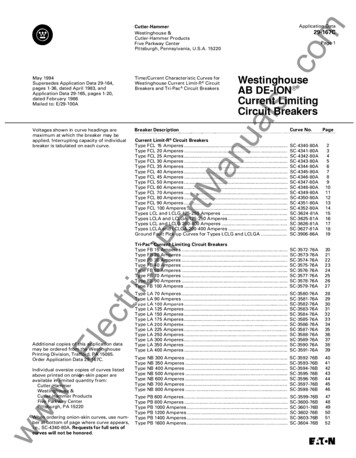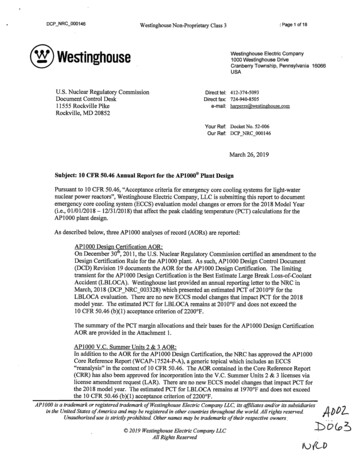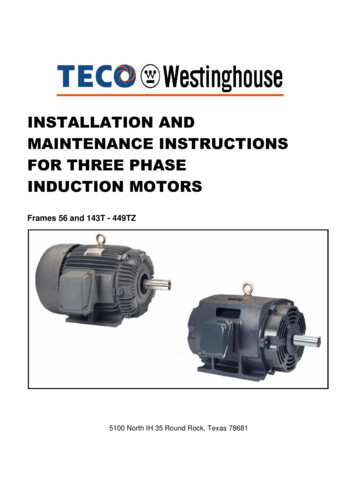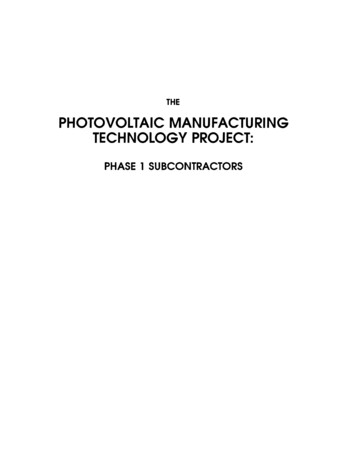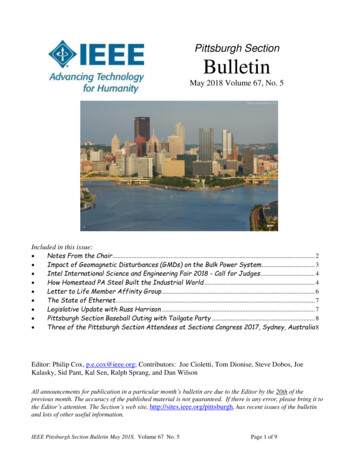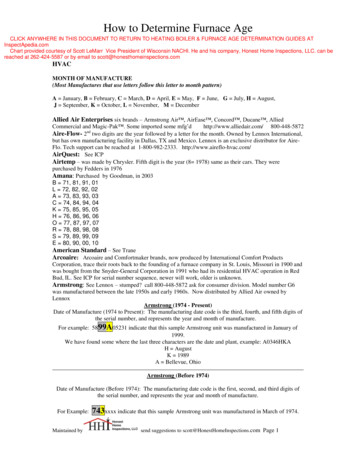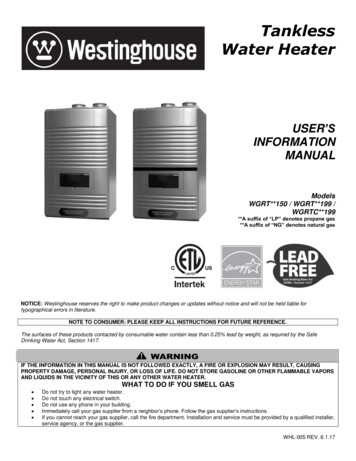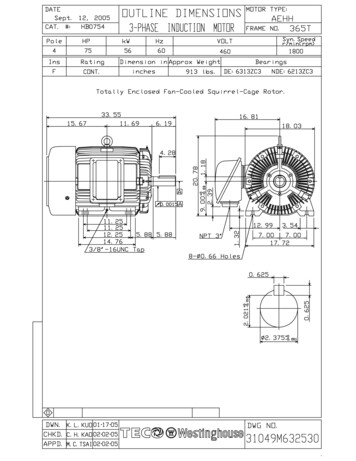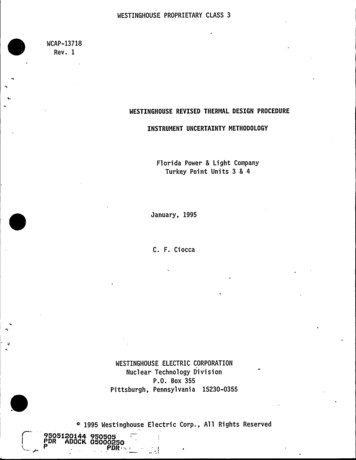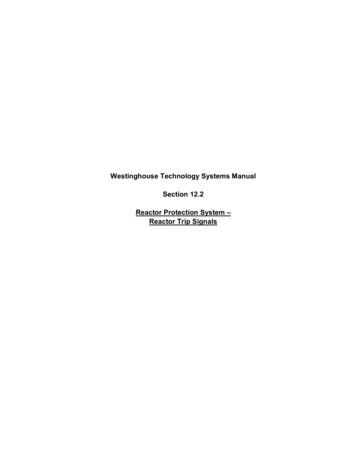
Transcription
Westinghouse Technology Systems ManualSection 12.2Reactor Protection System –Reactor Trip Signals
TABLE OF CONTENTS12.2 REACTOR PROTECTION SYSTEM - REACTOR TRIP SIGNALS. 12.2-112.2.1 Introduction . 12.2-112.2.2 Reactor Trip Functions . 12.2-112.2.3 Trip Signal Functions . 12.2-212.2.3.1 Manual Trip. 12.2-212.2.3.2 High Neutron Flux Trip - Source Range . 12.2-212.2.3.3 High Neutron Flux Trip - Intermediate Range . 12.2-312.2.3.4 High Neutron Flux Trip - Power Range . 12.2-312.2.3.5 Positive Neutron Flux Rate Trip - Power Range . 12.2-312.2.3.6 Negative Neutron Flux Rate Trip - Power Range . 12.2-312.2.3.7 Overtemperature ΔT Reactor Trip . 12.2-312.2.3.8 Overpower ΔT Reactor Trip . 12.2-512.2.3.9 Pressurizer Low Pressure Trip . 12.2-612.2.3.10 Pressurizer High Pressure Trip . 12.2-612.2.3.11 Pressurizer High Water Level Trip . 12.2-612.2.3.12 Low Reactor Coolant Flow Trips . 12.2-612.2.3.13 Low Feedwater Flow Trip . 12.2-712.2.3.14 Low-Low Steam Generator Water Level Trip . 12.2-712.2.3.15 Safety Injection Actuation Trip . 12.2-712.2.3.16 Reactor Trip on Turbine Trip . 12.2-712.2.4 Interlocks . 12.2-812.2.4.1 Control-Grade Interlocks. 12.2-812.2.4.2 Protection-Grade Interlocks . 12.2-1012.2.5 Summary . 12.2-13LIST OF TABLES12.2-1 Summary of Reactor Trips . 12.2-1412.2-2 Summary of Protection-Grade Interlocks . 12.2-1912.2-3 Summary of Control-Grade Interlocks. 12.2-21USNRC HRTD12.2-iRev 0109
LIST OF FIGURES12.2-1 . Reactor Protection System, Block Diagram12.2-2 . Source Range Reactor Trip Logic12.2-3 . Intermediate Range Reactor Trip Logic12.2-4 . Power Range Reactor Trip Logic12.2-5 . Power Range Flux Rate Trips12.2-6 . Overtemperature ΔT Channel Block Diagram12.2-7 . Overpower ΔT Channel Block Diagram12.2-8 . Pressurizer Low Pressure Reactor Trip12.2-9 . Pressurizer High Pressure Reactor Trip12.2-10 . Pressurizer High Water Level Reactor Trip12.2-11 .Low Flow Trips12.2-12 . Low Feedwater Flow Reactor Trip12.2-13 . Steam Generator Low-Low Water Level Reactor Trip12.2-14 . Turbine Trip - Reactor TripUSNRC HRTD12.2-iiRev 0109
12.2 REACTOR PROTECTION SYSTEM - REACTOR TRIP SIGNALSLearning Objectives:1. Given a list of reactor trips, explain the purpose (basis) of each.2. Given a list of Reactor Protection System (RPS) interlocks, explain the purposeof each.3. Given a list of control-grade interlocks, explain the purpose of each.12.2.1 IntroductionThe purposes of the reactor trip signals are to initiate a reactor trip if safe operatinglimits are exceeded. The safe operating limits bounded by these trips are monitoredby sensors and are compared to preselected bistable setpoints. If a processedparameter exceeds its associated setpoint, a reactor trip occurs. The specificfunctions of all reactor trips are discussed in the following sections.12.2.2Reactor Trip FunctionsThe philosophy of the reactor protection system is to define an area of permissibleoperation in terms of power, flow, axial power distribution, and primary coolanttemperature and pressure, so that the reactor is tripped when the limits of a selectedarea of concern are approached. When the protection system receives signalsindicative of an approach to an unsafe operating condition, the system actuatesalarms, prevents control rod withdrawal (if applicable), initiates a turbine runback (ifapplicable), and/or opens the reactor trip breakers. The overpower ΔT (OPΔT) andovertemperature ΔT (OTΔT) reactor trips provide core protection for situations inwhich: The transient is slow with respect to coolant piping delays from the core tothe temperature sensors, and Pressure is within the range between the high and low pressure reactor trips.Other reactor trips shown in Figure 12.2-1, such as the low coolant flow and highnuclear flux trips, provide core protection for accidents in which the loop ΔT signaldoes not respond quickly enough. Additional reactor trips, such as the highpressurizer water level and low feedwater flow trips, are provided primarily forequipment protection. Finally, some reactor trips, such as those produced by aturbine trip or reactor coolant pump circuit breaker opening, are provided toanticipate probable plant transients and tominimize the resulting thermal transienton the reactor coolant system (RCS). Descriptions of the reactor trips are providedin section 12.2.3 and in Table 12.2-1.Protection-grade interlocks (designated as P-n), also known as permissives, andcontrol-grade interlocks (designated as C-n) are also described in this section. Aninterlock blocks certain actions and permits others. Rod withdrawal stops areUSNRC HRTD12.2-1Rev 0109
examples of control-grade interlocks; they are provided to prevent abnormalconditions which could result in a trip in response to excessive control rodwithdrawal initiated by either a control system malfunction or a violation ofadministrative procedures by the operator. Descriptions of interlocks are provided insections 12.2.3 and12.2.4 and in Tables 12.2-2 and 12.2-3.A reactor trip is initiated by interrupting power to the rod cluster control assemblies(RCCAs). Power is delivered to the RCCAs from the rod drive motor generator setsthrough two series-connected trip breakers. Opening either trip breaker removespower to the rods. Each breaker is designed to trip open by spring action when asmall undervoltage coil in the breaker assembly is de-energized. When this coil isde-energized, it allows a mechanical latch to move, allowing the spring to open thetrip breaker. The undervoltage coil to reactor trip breaker (RTB) “A” is powered byprotection train AA,@ and that of RTB “B” is supplied by protection train AB.”Therefore, either protection train is capable of initiating a reactor trip, regardless ofthe action by the opposite train.12.2.3 Trip Signal FunctionsReactor trip signals are provided by the RPS to protect the plant during variousanalyzed transients or accidents. The reliability of the RPS is assured by providingmore than one trip function to protect the plant against the same event. Thefollowing provides a brief description of each of the various reactor trip signals.12.2.3.1 Manual TripThe manual actuating devices (reactor trip switches) are independent of theautomatic trip circuitry, and are not subject to the types of failures which may rendera portion of the automatic circuitry inoperable. Actuating either of the two manualreactor trip switches located in the control room initiates a reactor trip and a turbinetrip.12.2.3.2 High Neutron Flux Trip - Source RangeThis trip, Figure 12.2-2, occurs when at least one of the two source range channelsindicates greater than 105 cps. The source range trip provides protection againstreactivity excursions and startup accidents. This trip may be manually blocked whenat least one of the two intermediate range channels exceeds the P-6 setpoint valueof 10-10 amps, and the trip function is automatically reinstated when bothintermediate range channels decrease below the P-6 setpoint.When this trip is manually blocked, power is removed from the source range neutrondetectors, de-energizing both channels. The operator can manually restore powerto the source range detectors by momentarily placing the BLOCK-RESET switchesto reset. When the P-10 permissive setpoint (10% power on the power rangeinstruments) is exceeded, the altered reset logic prevents the operator frominadvertently energizing the source range detectors. Applying a high voltage tothese detectors in the presence of a high neutron flux could damage the detectors.USNRC HRTD12.2-2Rev 0109
12.2.3.3 High Neutron Flux Trip - Intermediate RangeThis trip, Figure 12.2-3, occurs when the current output from at least one of the twointermediate range channels indicates greater than the equivalent of 25% power.The intermediate range trip, which provides protection against reactivity excursionsand startup accidents, can be manually blocked if at least two of the four powerrange channels exceed 10% of full power (P-10). If at least three of four (3/4) powerrange channels fall below the P-10 setpoint value, the trip function is automaticallyreinstated.12.2.3.4 High Neutron Flux Trip - Power RangeThis trip, Figure 12.2-4, occurs when at least two of the four (2/4) power rangechannels indicate greater than the trip setpoint. Two independent trips are provided:a high setting at 109% and a low setting at 25%. The high trip setting providesprotection against overpower during normal power operations. The low setting,which provides protection against reactivity excursions and startup accidents, can bemanually blocked when at least two of the four power range channels indicategreater than 10 percent of full power (P-10).If at least three of the four power range channels drop below 10 percent power, thelow power trip function is automatically reinstated. The high trip setting is alwaysactive (cannot be blocked). Before reactor power reaches the 109% trip setpoint, asignal is generated to block automatic and manual rod withdrawal. This actionoccurs if at least one of the four power range channels exceeds 103% power (the C2 interlock).12.2.3.5 Positive Neutron Flux Rate Trip - Power RangeThis trip, Figure 12.2-5, occurs when an abnormal rate of increase in nuclear power( 5% with a 2 second time constant) occurs in at least two of the four power rangechannels. This trip provides protection for rod ejection accidents and cannot bebypassed or blocked. A rate trip in a particular RPS channel “seals in”; it remains ineffect until the operator resets the trip at the appropriate nuclear instrument drawer.12.2.3.6 Negative Neutron Flux Rate Trip - Power RangeThis trip, Figure 12.2-5, occurs when an abnormal rate of decrease in nuclear power(-5% with a 2 second time constant) occurs in at least two of the four power rangechannels. This trip provides protection against dropped rod accidents and cannotbe bypassed or blocked. A rate trip in a particular RPS channel “seals in”; it remainsin effect until the operator resets the trip at the appropriate nuclear instrumentdrawer.12.2.3.7 Overtemperature ΔT Reactor TripThe OTΔT trip, Figure 12.2-6, is designed to protect against departure from nucleateboiling (DNB), which causes a large decrease in the heat transfer coefficientbetween the fuel rods and the reactor coolant, resulting in high fuel cladtemperatures. In each of the four reactor protection channels, the calculated loopUSNRC HRTD12.2-3Rev 0109
ΔT, a measure of reactor power, is compared with a continuously calculated tripsetpoint. This setpoint is a function of Tavg, pressurizer pressure, and axial fluxdifference.(Separate inputs of Tavg, pressurizer pressure, and axial flux differenceare used in each reactor protection channel.) If the calculated ΔT equals thecalculated trip setpoint, the affected channel is tripped. If two or more channels aresimultaneously tripped, the reactor is automatically tripped. The equation for thecalculation of the OTΔT setpoint is:OTΔT setpoint ΔT0 [K1 – K2( 1 τ1S )(T – T’) K3(P – P’) – f1(ΔI)]1 τ2Swhere:ΔT0 indicated ΔT at rated thermal power, in terms of percent reactor power.T measured RCS average temperature (Tavg), F.T’ nominal Tavg at rated thermal power, 584.7 F.P pressurizer pressure, psig.P’ nominal RCS operating pressure, 2235 psig.S Laplace transform operator, sec-1.1 τ1S function generated by the lead-lag controller for Tavg dynamic1 τ2Scompensation.τ1 lead time constant, sec.τ2 lag time constant, sec.K1 manually adjusted preset bias that sets the steady-state trip setpoint whenother parameters are at their rated values.K2, K3 manually adjusted preset gains.f1(ΔI) function of axial flux difference.The Tavg term in the equation acts to lower the trip point when Tavg is greater thanthe normal full power Tavg. This correction is necessary because the increasedaverage temperature reduces the margin to DNB. The pressure signal reduces theΔT setpoint when pressure is lower than rated, since this condition also reduces themargin to DNB. The f1(ΔI) term reduces the value of the trip setpoint to reflect anincrease in the hot channel factors which could result in localized DNB. Generally,the ΔI function does not affect the OTΔT trip setpoint (the function value is set to 0)when core power is evenly or fairly evenly distributed axially; it dramatically reducesthe OTΔT trip setpoint for very large positive or negative values of axial fluxdifference. This correction ensures that DNB is not approached even for highlyskewed power distributions. The OTΔT trip ensures a DNBR of not less than 1.30at the time of the reactor trip if: The transient is slow with respect to piping transient delays from the core tothe temperature detectors and The reactor coolant pressure is within the bounds set by the high and lowpressure trips.Prior to the actual ΔT reaching the OTΔT trip setpoint, both automatic and manualcontrol rod withdrawal is inhibited, and a cyclic turbine runback is initiated, as longUSNRC HRTD12.2-4Rev 0109
as the overtemperature condition exists. This action occurs if the calculated ΔTvalues in at least two of the four protection channels are within 3% of the tripsetpoint.12.2.3.8 Overpower ΔT Reactor TripThe OPΔT trip, Figure 12.2-7, is designed to protect against a high fuel rod powerdensity (excessive kw/ft) and subsequent fuel melt and fuel rod cladding failure.Fuel melt is avoided by limiting the fuel centerline temperature to less than 4700 F,which is significantly below the actual UO2 melting temperature. In each of the fourreactor protection channels, the calculated loop ΔT, a measure of reactor power, iscompared with a continuously calculated trip setpoint that is automatically calculatedas a function of Tavg and axial flux difference. (Separate inputs of Tavg and axial fluxdifference are used in each reactor protection channel.) If the ΔT signal exceedsthe calculated setpoint, the affected channel is tripped. If two or more channels aresimultaneously tripped, the reactor is automatically tripped. A turbine runbackoccurs and automatic and manual rod withdrawal is inhibited when, in at least twoprotection channels, the ΔT value reaches 3% below the trip setpoint. Since corethermal power is not precisely proportional to ΔT due to the effects of changes incoolant density and heat capacity, a compensating term, a function of averagetemperature, is used. Similarly, since the prescribed overpower limit may not beadequate for highly skewed axial power distributions, a compensating term relatedto ΔI is used. The setpoint equation is:OPΔT setpoint ΔT0 [K4 – K5(τ3S )T K6(T – T’) – f2(ΔI)]1 τ3Swhere:ΔT0 indicated ΔT at rated thermal power, in terms of percent reactor power.T measured RCS average temperature (Tavg), F.T’ nominal Tavg at rated thermal power, 584.7 F.S Laplace transform operator, sec-1.τ3S function generated by the rate-lag controller for Tavg dynamic1 τ3Scompensation.τ3 rate-lag time constant, sec.K4 manually adjusted preset bias that sets the steady-state trip setpoint whenother parameters are at their rated values.K5, K6 manually adjusted preset gains.f2(ΔI) function of axial flux difference.The (T - T ) term effectively imposes an upper limit for the setpoint based on fullpower. Since it is possible for the average temperature to exceed the programmedfull power average temperature, the setpoint must be reduced to take into accountthe increase in the heat capacity of the reactor coolant at higher temperatures. Thisterm can only decrease the OPΔT trip setpoint from its normal full power value.USNRC HRTD12.2-5Rev 0109
Prior to the actual ΔT reaching the OPΔT trip setpoint, both automatic and manualcontrol rod withdrawal is inhibited, and a cyclic turbine runback is initiated, as longas the overpower condition exists. This action occurs if the calculated ΔT values inat least two of the four protection channels are within 3% of the trip setpoint.12.2.3.9 Pressurizer Low Pressure TripThe pressurizer low pressure trip, Figure 12.2-8, protects against excessive coresteam voids and limits the range of required protection afforded by the OTΔT trip.The reactor trips when at least two of four pressurizer pressure signals fall below1865 psig. This trip is automatically blocked when turbine first-stage pressure orreactor power is less than 10 percent power (P-7 permissive).12.2.3.10 Pressurizer High Pressure TripThe pressurizer high pressure trip protects against reactor coolant systemoverpressure, thereby protecting the RCS pressure boundary. As shown in Figure12.2-9, the reactor trips when two of four high pressurizer pressure signals exceed2385 psig. This trip is always in service and cannot be bypassed or blocked.12.2.3.11 Pressurizer High Water Level TripThe pressurizer high water level trip, shown in Figure 12.2-10, protects againstoverpressurization of the RCS resulting from rapid thermal expansions of reactorcoolant which fill the pressurizer. In addition, if the pressurizer fills completely withwater, relieving water instead of steam could be damaging to the relief and safetyvalves. The reactor is tripped when two of three pressurizer water level signalsexceed 92%. This trip is automatically blocked below 10 percent power (P-7).12.2.3.12 Low Reactor Coolant Flow TripsThe low flow reactor coolant flow trips protect the core from DNB following a loss ofcoolant flow. The means of generating a low flow are shown in Figure 12.2-11 anddescribed below:1. Low primary coolant flow trip: A low loop flow signal is generated by two-out-ofthree low flow signals per loop. Above the P-7 setpoint (approximately 10% offull power), a low flow in two or more loops results in a reactor trip. Above the P8 setpoint (39% of full power) low flow in any single loop results in a directreactor trip.2. Reactor coolant pump breaker position trip: A contact associated with eachreactor coolant pump power supply breaker supplies a signal to the logic sectionof the reactor protection system. The reactor trips if at least two reactor coolantpump breakers open.3. RCP bus under-voltage trip: The RCP under-voltage trip anticipates, andimproves the response of the RPS to, a complete loss of reactor coolant flow.Each of the two RCP busses is equipped with two under-voltage sensors. AnUSNRC HRTD12.2-6Rev 0109
under-voltage condition, as sensed by one of two (1/2) devices on an individualbus, must exist on two of two (2/2) RCP busses to produce a reactor trip.4. RCP bus under-frequency trip: An under-frequency condition on the RCP bussesreduces the speed of the pumps (with a subsequent reduction in flow). This isundesirable because it reduces the coastdown time of the pumps if power is lostto the busses. Each of the two RCP busses is equipped with two underfrequency sensors. An under-frequency condition, as sensed by one of twodevices on an individual bus, must exist on two of two RCP busses to produce areactor trip. In addition to tripping the reactor, satisfaction of the underfrequency trip logic also trips the RCPs.All the reactor coolant low flow trips are automatically blocked below the P-7setpoint (10% power).12.2.3.13 Low Feedwater Flow TripThe low feedwater flow trip, Figure 12.2-12, protects the reactor from a loss of heatsink (steam generator secondary inventories). The trip is actuated by the logic of asteam flow greater than feed flow mismatch signal (1/2) coincident with a steamgenerator low level (1/2) in at least one steam generator. This trip is anticipatory inthat a steam generator’s level has not yet reached the low-low level setpoint (seethe next section) but is trending toward it.12.2.3.14 Low-Low Steam Generator Water Level TripThis trip (Figure 12.2-13) protects the reactor against a loss of heat sink. Thesetpoint of this trip is 11.5%, as indicated by the narrow-range steam generator levelinstruments. The trip logic is satisfied by two of three (2/3) levels below the low-lowsetpoint in at least one steam generator.12.2.3.15 Safety Injection Actuation TripIf a reactor trip has not already been generated by any other trip signal, the safetyinjection (SI) actuation signal initiates a trip when the RPS senses any conditionwhich initiates safety injection. The SI actuation trip protects the core in the event ofa loss of coolant accident or a steam line break accident.The safety injection actuation signals are discussed in Section 12.3.12.2.3.16 Reactor Trip on Turbine TripThe turbine trip - reactor trip signal, Figure 12.2-14, protects the reactor coolantsystem from a thermal transient (overpressure or overtemperature) when the energyremoval from the coolant abruptly diminishes. This trip occurs for power levelsgreater than 10% (P-7), or in plants with the P-9 permissive, for levels greater than50%. The signals used to sense that the turbine has tripped are:1. Four of four (4/4) turbine throttle (stop) valves fully closed, orUSNRC HRTD12.2-7Rev 0109
2. Two of three low turbine electrohydraulic control system trip header fluidpressures (setpoint: 800 psig) for a General Electric turbine, or two of three lowauto-stop oil pressures (setpoint: 45 psig) for a Westinghouse turbine.See Sections 11.3 and 11.5 for additional details.12.2.4 InterlocksVarious signals are generated throughout the plant for the purpose of:1. Automatically prohibiting and/or allowing the actuation of certain protectivefunctions and the operation of certain control systems, and2. Allowing the operator to manually prohibit certain protective actions.The interlocks are divided into two broad categories, designated as protection-grade(P) interlocks (permissives) and control-grade (C) interlocks. Protection-gradeinterlocks are developed within the solid-state protection system. Control-gradeinterlocks are developed within the process instrumentation racks (with theexception of C-8). Although not part of the protection system, the control-gradeinterlocks are discussed here for the sake of completeness.12.2.4.1 Control-Grade InterlocksAn interlock is a signal or equipment status that prevents or allows an action or afunction when a certain set of conditions exist. Listed below are the control-gradeinterlocks (designated by the C-n convention) employed in most Westinghousereactor plants. The “C” designation differentiates them from RPS permissives (“P”designation), as previously discussed.C-1: High Neutron Flux Rod Stop InterlockAt least one of two intermediate range detector currents exceeding the equivalent of20% power generates a rod withdrawal stop for both automatic and manual rodcontrol. The rod stop may be blocked with reactor power (power range) at or abovethe P-10 setpoint (2/4 coincidence), but it is automatically reinstated when powerdrops below the P-10 setpoint (3/4 coincidence).C-2: Overpower Rod Stop InterlockIf at least one of the four excore power range flux detectors indicates a power outputof greater than 103%, an automatic and manual rod withdrawal stop is actuated.This interlock may be bypassed by the operator to allow for continued operation withone inoperable power range channel.C-3: OTΔT Rod Stop and Turbine Runback InterlockWhen the calculated loop ΔT in at least two of four protection channels is withinthree percent of the OTΔT trip setpoint, automatic and manual rod withdrawal isblocked, and a turbine runback is initiated.USNRC HRTD12.2-8Rev 0109
C-4: OPΔT Rod Stop and Turbine Runback InterlockWhen the calculated loop ΔT in at least two of four protection channels is withinthree percent of the OPΔT trip setpoint, automatic and manual rod withdrawal isblocked, and a turbine runback is initiated.C-5: Low Power InterlockThe setpoint for this interlock is 15% load, as sensed by turbine impulse pressure. Ifload drops below 15%, automatic rod withdrawal is inhibited. The C-5 interlock issupplied by a particular turbine impulse pressure sensor that cannot be changed bythe operator.C-7: Loss of Load InterlockThis interlock is actuated by a reduction in turbine load of sufficient severity; it armsthe steam dump control system (allows steam dump valves to open if an opendemand exists). C-7 senses must be manually reset. It is actuated by a turbineload decrease larger in magnitude than a 10% step drop or a 5%/min rampdecrease.C-8: Turbine Tripped InterlockWhen the C-8 interlock is actuated, the steam dump control system (if in the Tavgmode of control) shifts from the load-rejection controller to the turbine-trip controller.Permissive C-8 requires:1. Four of four (4/4) turbine throttle (stop) valves fully closed, or2. Two of three low turbine electrohydraulic control system trip header fluidpressures (setpoint: 800 psig) for a General Electric turbine, or two of three lowauto-stop oil pressures (setpoint: 45 psig) for a Westinghouse turbine.In addition, C-8 arms the steam dumps. The C-8 interlock is not installed inWestinghouse-designed units that have the P-9 permissive.C-9: Condenser Available InterlockThe condenser must be available in order to allow steam dump operation. Toactuate C-9, one of two (1/2) circulating water pump breakers must be shut AND twoof two condenser vacuum switches must be shut ( 5 in. Hg backpressure). Ifbackpressure in the condenser increases to 7.6 in. Hg, then the C-9 interlock isremoved.C-11: Control Bank D Rod Withdrawal Limit InterlockThis signal prevents misalignment of rod position step counters by blockingautomatic withdrawal of control bank D when the bank D position has reached 223steps.USNRC HRTD12.2-9Rev 0109
12.2.4.2 Protection-Grade InterlocksDuring controlled plant evolutions, certain protection signals are not required forplant safety and may be blocked to prevent inadvertent reactor trips or engineeredsafety features (ESF) actuations. These signals are disabled automatically by theRPS or manually by the operator. The mechanisms for blocking these trips are theprotection-grade interlocks, or permissives. The protection system is designed sothat any signal which had been blocked is automatically reinstated whenever theconditions allowing that block (a satisfied permissive) are no longer met (This designconvention is required by IEEE Std. 279-1971). The following provides briefdescriptions of the various permissives.P-4: Reactor Trip PermissiveThis permissive is derived from the status of "b" contacts on the reactor trip breakers(RTBs). (Each contact is closed when the associated RTB is open, and open whenthe RTB is closed). The permissive is satisfied whenever an RTB is open. Itperforms the following functions:1.2.3.4.Actuates a turbine trip,Initiates main feedwater isolation with RCS temperature below 564 F,Inputs to the SI actuation block-reset logic, andPrevents opening of the main feedwater isolation valves which had been closedby an SI actuation signal or high-high steam generator level (P-14).Permissive P-4 (and P-14, as discussed below) is not a permissive signal in theclassic sense, in that it does not enable or reinstate some switch or function. It doesnot have associated status lights on protection system bistable status panels in thecontrol room.P-6: Source Range Block PermissivePermissive P-6 enables the source range block-reset switches on the main controlboard. The operator can then place the switches in the “block” position to removepower from the source range detectors, thereby blocking the source range high fluxtrip. During a power increase when at least one of two intermediate range channelsis greater than 10-10 amps, permissive P-6 is in effect. During a power decreasewhen BOTH intermediate range channel outputs drop below 10-10 amps, permissiveP-6 is removed.P-7: At-Power PermissiveAt-power permissive P-7 is in effect below 10% power and automatically blocks theat-power trips listed below: Two-loop low reactor coolant flow trip,RCP power supply breaker trip,RCP bus under-voltage trip,RCP bus under-frequency trip,USNRC HRTD12.2-10Rev 0109
Pressurizer low pressure trip,Pressurizer high level t
Westinghouse Technology Systems Manual Section 12.2 Reactor Protection System - Reactor Trip Signals. USNRC HRTD 12.2-i Rev 0109 TABLE OF CONTENTS . through two series-connected trip breakers. Opening either trip breaker removes power to the rods. Each breaker is designed to trip open by spring action when a
